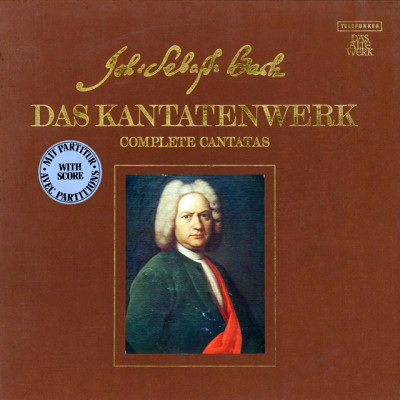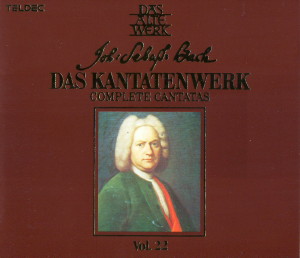 |
|
2 LPs
- 6.35364 EX - (p) 1979
|
 |
| 2 CDs -
8.35364 ZL - (c) 1989 |
|
| DAS KANTATENWERK - Volume 22 |
|
|
|
|
|
|
|
| Johann Sebastian
BACH (1685-1750) |
Kantate
"Siehe, ich will viel Fischer aussenden",
BWV 88
|
|
18' 37" |
|
|
Kantate
am 5. Sonntag nach Trinitatis (Dominica
5 post Trinitatis)
|
|
|
|
|
Text:
Textdichter unbekannt; 1. Jeremia 16,16;
Lukas 5,10; 7. Georg Neumark 1641
|
|
|
|
|
Solo:
Sopran, Alt, Tenor, Baß - Chor; Horn I,
II; Oboe d'amore I, II; Oboe da caccia;
Streicher; B.c. (Violoncello, Violone,
Organo)
|
|
|
|
|
Prima
parte
|
|
|
|
|
- 1.
Aria (Basso): "Siehe, ich will viel
Fischer aussenden" |
6' 45" |
|
C1 |
|
- 2.
Recitativo (Tenore): "Wie leichtlich
könnte doch der Höchste uns entbehren" |
0' 42" |
|
C2 |
|
- 3.
Aria (Tenore): "Nein, Gott ist allezeit
geflissen" |
3' 50" |
|
C3 |
|
Seconda
parte
|
|
|
|
|
- 4.
Aria (Tenore, Basso): "Fürchte dich nicht" |
2' 11" |
|
C4 |
|
- 5.
Aria - Duetto (Soprano, Alto): "Beruft
Gott selbst, so muß der Segen" |
3' 07" |
|
C5 |
|
- 6.
Recitativo (Soprano): "Was kann dich denn
in deinem Wandel schrecken" |
1' 17" |
|
C6 |
|
- 7.
Choral: "Sing, bet und geh auf Gottes
Wegen" |
0' 45" |
|
C7 |
|
|
|
|
|
|
Kantate
"Was soll ich aus dir machen, Ephraim?",
BWV 89 |
|
12' 11" |
|
|
Kantate
am 22. Sonntag nach Trinitatis (Dominica
22 posr Trinitatis) |
|
|
|
|
Text:
Textdichter unbekannt; 1. Hosea II,8; 6.
Johann Heermann 1630 (Wo soll ich fliehen
hin) |
|
|
|
|
Solo:
Sopran, Alt, Baß - Chor; Corno da caccia;
Oboe I, II; Streicher; B.c. (Violoncello,
Violone, Organo) |
|
|
|
|
- 1.
Aria (Basso): "Was soll ich aus dir
machen, Ephraim?" |
4' 25" |
|
D1 |
|
- 2.
Recitativo (Alto): "Ja, freilich sollte
Gott" |
0' 40" |
|
D2 |
|
- 3.
Aria (Alto): "Ein unbarmherziges Gerichte" |
2' 32" |
|
D3 |
|
- 4.
Recitativo (Soprano): "Wohlan! mein Herze
legt Zorn" |
1' 05" |
|
D4 |
|
- 5.
Aria (Soprano): "Gerechter Gott, ach,
rechnest du?" |
2' 51" |
|
D5 |
|
- 6.
Choral: "Mir mangelt zwar sehr viel" |
0' 38" |
|
D6 |
|
|
|
|
|
|
Kantate
"Es reifet euch ein schrecklich Ende",
BWV 90 |
|
12' 04" |
|
|
Kantate
am 25. Sonntag nach Trinitatis (Dominica
25 posr Trinitatis) |
|
|
|
|
Text:
Textdichter unbekannt; 5. Martin Moller
1584 (Nimm von uns, Herr, du treuer Gott) |
|
|
|
|
Solo:
Alt, Tenor, Baß - Chor; Naturtrompete;
Streicher; B.c. (Violoncello, Violone,
Organo) |
|
|
|
|
- 1.
Aria (Tenore): "Es reifet euch ein
schrecklich Ende" |
6' 03" |
|
D7
|
|
- 2.
Recitativo (Alto): "Des höchsten Güte wird
von Tag zu Tag neu" |
1' 16" |
|
D8
|
|
- 3.
Aria (Basso): "So löschet im Eifer der
rächende Richter" |
3' 31" |
|
D9
|
|
- 4.
Recitativo (Tenore): "Doch Gottes Auge
sieht auf uns als Auserwählte" |
0' 33" |
|
D10
|
|
- 5.
Choral: "Leit uns mit deiner rechten Hand"
|
0' 41" |
|
D11
|
|
|
|
|
|
Marcus
Klein (Solist des Knabenchores
Hannover), Sopran (BWV 88 &
89)
Paul Esswood, Alt
Kurt Equiluz, Tenor (BWV 88 &
90)
Max van Egmond, Baß
Knabenchor Hannover |
Heinz Hennig, Leitung
Collegium Vocale Gent | Philippe
Herreweghe, Leitung
Das verstärkte LEONHARDT-CONSORT mit
Originalinstrumenten
- Don Smithers, Tromba (Naturtrompete)
- Ab Koster, Corno da caccia
- Ab Koster, Horn I
- Jos Konings, Horn II
- Ku Ebbinge, Oboe I
- Bruce Haynes, Oboe II
- Bruce Haynes, Oboe d'amore I
- Ku Ebbinge, Oboe d'amore II
- Pieter Dhont, Oboe da caccia
- Marie Leonhardt, Alda Stuurop (BWV 88,1,7;
89; 90,3,5), Lucy van Dael (BWV 88,1,7; 89;
90,3,5), Janneke van der Meer (BWV 88,3,4,5;
90,1), Ruth Hesseling (BWV 88,3,4,5; 90,1),
Antoinette van den Hombergh, Keiko Watanabe,
Violinen
- Wiel Peeters, Win ten Have, Violen
- Anner Bylsma, Richte van der Meer (BWV
80,1,7), Wouter Möller (BWV 88,3,5), Lidewij
Schijfes (BWV 88,4; 90,1), Dijck Koster (BWV
89,1,6; 90,3,5), Violoncelli
- Anthony Woodrow, Violone
- Gustav Leonhardt (BWV 88,2,6; 89,2,3,4,5;
90,2,4), Glenn Wilson (BWV 88,1,4,7; 89,1,6;
90,1,3,5), Bob van Asperen (BWV 88,3,5), Orgel
Gustav Leonhardt, Gesamtleitung
|
|
|
|
|
Luogo
e data di registrazione |
|
Amsterdam (Holland) -
Marzo / Settembre 1978
|
|
|
Registrazione:
live / studio |
|
studio |
|
|
Producer |
|
Wolf Erichson
|
|
|
Prima Edizione
LP |
|
Telefunken "Das Alte
Werk" | 6.35364 EX | 2 LPs -
durata 59' 42" - 44' 09" | (p)
1979 | ANA
|
|
|
Edizione CD |
|
Teldec Classics |
LC 6706 | 8.35364 ZL | 2 CDs -
durata 59' 42" - 44' 09" | (c)
1989 | ADD |
|
|
Cover
|
|
Johann Sebastian
Nach, einige Jahre vor seiner
Ernennung zum Kantor in Leipzig.
Gemälde con JJ. Ihle (1720) Bach
Museum Eisenach.
|
|
|
Note |
|
In questo volume sono
presenti anche La Cantate BWV 84,
BWV 85, BWV 86 e BWV 87 a
cura del Concentus Musicus Wien
diretto da Nikolaus Harnoncourt.
|
|
|
|
|
INTRODUCTION
by Ludwig Finscher
»Siehe, ich will viel
Fischer aussenden« (BWV
88) was written for
the fifth Sunday after
Trinity (21st July) 1726,
almost immediately after
Bach had introduced a series
of works by his cousin in
Meiningen, Johann Ludwig
Bach, to the St. Thomas
Church instead of his own
cantatas. At least the form
of the anonymous text - as
with the cantatas BWV 39,
187, 45, 102 and 17,
composed more or less around
the same period -
corresponds precisely with
that of this group of
inserted works. Thus it
seems reasonable to assume
that Bach instructed a
Leipzig poet to write texts
in this form, or that he
himself undertook the task.
The focal point of these
texts is a quotation from
the Sunday gospel in
question, symmetrically
framed by two arias and two
recitatives. Before the
first recitative there is a
quotation from the Old
Testament, the sense of
which is related to the
passage from the gospel,
while the second recıtative
is followed by the
concluding chorus. On the
whole this is an arrangement
which is not only satisfying
from the musical point of
view, but theologically is
also eminently significant
(with the New Testament at
the centre, the Old
Testament at the beginning
and the congregation hymn at
the end).
Bach’s composition places
almost too much emphasis
upon the quotation from the
Old Testament, in the sense
that it transposes its
graphic language into two
broad and splendidly painted
genre scenes, a marine and a
hunting piece. Beneath their
colourful surface they are
extremely artistically
designed, and are set in
contrast to each other. The
short but harmoniously rich
first recitative leads on to
the tenor aria which,
without a ritornello,
answers the question of the
recitative. It is not until
after the contrasting vocal
sections, held together by
the motif treatment of the
oboe d’amore, that the
ritornello is subsequently
featured as an abbreviated
da capo, with the oboe
d’amore adopting the role of
the vocal part. The Gospel
quotation is introduced by a
two-bar Evangelist arioso
and is then taken up in the
bass (the »vox Christi«) as
a solemn, four-part arioso
(A A’ A A’’) above a quasi
ostinato bass. The duet once
more reverts to the
motet-like sequence form and
the technique of varying
repetition which dominate
the entire cantata and give
Bach an opportunity of
declaiming the text with
unusual intensity and ever
fresh shading. Two text
sections, the second being
repeated, are arranged in an
artistically polyphonic
three-movement setting (A
A’A’’). The final chorus
after the second recitative
is kept in a comparatively
simple song-like style.
»Was soll ich aus dir
machen, Ephraim?« (BWV 89)
has its origins in the first
Leipzig annual cantata set
and was composed for the
24th October, 1723 (22nd
Sunday after Trinity). The
text, again anonymous,
begins with a quotation from
the Old Testament which
hints at the Sunday Gospel
reading, and is then
construed in a double
sequence of recitative and
aria. The impact of the Old
Testament speech inspired
Bach to compose a grandiose
gloomy introductory piece.
This is a bass arioso of the
highest rhetorical power
around which oboes, strings
and continuo (the horn has
only a tone-supporting
function), three contrary
motifs, sighs, pathos-laden
chordal breaks and murmuring
semiquavers develop in
constantly new
constellations. The two
arias stand out from this
powerful movement on account
of markedly simple
instrumentation, but at the
same time are designed as a
contrasting pair. The
contralto aria (only with
continuo) conjures up once
more in D minor the terrors
of the Old Testament court
(not by coincidence with the
aid of that already slightly
archaic theme type, ascribed
in BWV 106 to the »old
alliance«. The soprano aria
in B-flat major with
obbligato oboe, prepared by
way of the arioso concluding
phrase of the second
recitative, sings of the
hope in Christ’s redeeming
sacrifice in almost
dancelike grace and in a
relaxed mood. The concluding
chorus is again a simple,
song-like setting, although
not entirely without
text-construing, harmonious
surprises.
»Es reißet euch ein
schrecklich Ende« (BWV 90)
was composed for the 25th
Sunday after Trinity, that
is to say, 14th November,
1723 and thus also belongs
to the first Leipzig annual
cantata set. The anonymous
text concentrates on the
visions of horror of the
final period before the last
judgement; the hope of the
»chosen peoples is not
uttered until the second
recitative and the chorus.
The deadly earnestness of
this text is matched by the
almost gloomy composition,
which with uncustomary
persistence circles around D
minor (the principle key)
and g minor, and which in
the two chief arias
dominating the work depict
the text emotions in a
highly drastic fashion: the
»snatching«, terrible end
and the sinfulness of man in
vehement coloraturas,
chromatic runs, torn off
phrases and catapulted
declamatory motifs in the
highest tenor pitch; the
vision of the zealous judge
of the world in grandiose
war music, completely built
up on signal motifs, with
concertante trumpet, the
symbolic instrument of war
fare. The two secco
recitatives are brief and
unadorned, but worked out
down to the last text
detail, declamatory and
harmoniously. In particular
the first, which contrasts
God’s goodness and the
world’s ingratitude,
displays an abundance and
power of musical depiction
of the text which were not
customary even for Bach. The
concluding chorus is
song-like setting which
begins in simple fashion and
then increases in harmonious
splendour, culminating in
one of Bach’s most
astounding harmony
applications (inserted
D-flat major on the word
»Stündlein«) and eventually
fading out on the sustained
D major (»ewig bei dir
seins).
|
  |
|
|